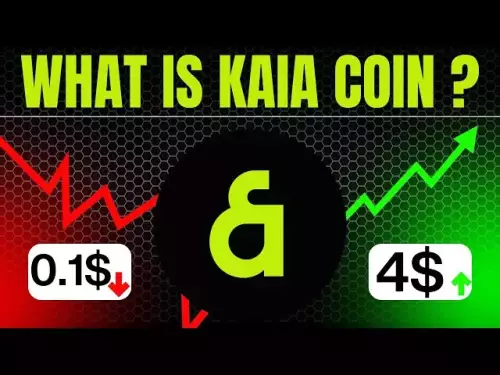 |
|
 |
|
 |
|
 |
|
 |
|
 |
|
 |
|
 |
|
 |
|
 |
|
 |
|
 |
|
 |
|
 |
|
 |
|
Cryptocurrency News Articles
Token Economy, AI Inference, and the New Gold Rush: Decoding the AI Investment Boom
Oct 10, 2025 at 06:00 pm
Explore the intersection of token economies and AI inference, as companies leverage advanced hardware like NVIDIA's Blackwell platform to unlock unprecedented returns on AI infrastructure investments.

The AI landscape is rapidly evolving, with 'Token economy, AI inference, gold rush' becoming increasingly intertwined. Companies are no longer just experimenting with AI; they're building AI factories. This shift is fueled by advancements in AI inference and the potential for massive token revenue generation.
AI Inference: The Engine of the Token Economy
AI models are now capable of complex reasoning, demanding more compute power. This has made AI inference – the process of running trained AI models to generate predictions or outputs – a major driver of compute costs. However, it's also where the real value of AI is delivered daily. As Ian Buck, vice president at NVIDIA, puts it, inference is where AI delivers value every day.
NVIDIA's Blackwell: Striking Gold in the AI Inference Rush
NVIDIA's Blackwell platform is emerging as a leader in AI inference, offering both strong performance and efficiency. The InferenceMAX v1 benchmark demonstrates that a $5 million NVIDIA GB200 NVL72 system could generate approximately $75 million in token revenue – a 15x ROI. This kind of return is reshaping how companies approach AI infrastructure investment.
Efficiency as the New Performance Metric
Throughput is no longer the only metric that matters. Efficiency metrics, such as tokens per watt and cost per million tokens, are crucial for profitability in large AI data centers. Blackwell delivers 10x more throughput per megawatt and cuts the cost per million tokens by 15x compared to the previous generation. Rubin CPX is designed for a split approach: Rubin CPX tackles the context-heavy front end while Rubin GPUs and Vera CPUs manage the generation phase. Nvidia's Dynamo software keeps the handoff smooth, moving data quickly between memory and compute so the system doesn’t stumble.
The Role of Open Source and Software Optimization
NVIDIA's collaborations with the open-source community, including OpenAI, Meta, and DeepSeek AI, have been instrumental in optimizing model performance. Software tweaks, like the TensorRT LLM library, further enhance performance by improving parallelization and boosting throughput.
The Bitcoin and Gold Rush Parallels
The AI investment boom shares similarities with the recent surges in gold and Bitcoin values. Just as gold is seen as a safe haven during economic uncertainty, AI infrastructure is becoming an attractive alternative investment. This is fueled by the potential for high returns and the increasing adoption of AI across various industries. As the article in Deutsche Welle pointed out, Bitcoin's growth has been largely fueled by the re-election of Donald Trump as US president, whose outspoken support for cryptocurrencies is boosting confidence and demand in the sector, which is reminiscent of the trend seen with gold. Similarly, the AI sector's growth is fueled by the re-election of confidence of the AI sector.
From Experiments to AI Factories
The AI industry is transitioning from experimental projects to full-scale AI factories. Benchmarks like InferenceMAX and frameworks like NVIDIA’s Think SMART are helping organizations choose the right hardware, control costs, and plan for service-level targets as their AI workloads expand.
The Future of AI Investment
Rubin CPX is presented as both a technical advance and a financial opportunity, estimating that every $100 million invested in the platform could yield up to $5 billion in token revenue. That kind of return, if borne out in real deployments, would reset the benchmarks for AI investment.
So, are you ready to stake your claim in this new AI gold rush? With the right tools and strategies, the potential for striking it rich in the token economy is definitely within reach. Just remember to bring your pickaxe and a whole lot of compute power!
Disclaimer:info@kdj.com
The information provided is not trading advice. kdj.com does not assume any responsibility for any investments made based on the information provided in this article. Cryptocurrencies are highly volatile and it is highly recommended that you invest with caution after thorough research!
If you believe that the content used on this website infringes your copyright, please contact us immediately (info@kdj.com) and we will delete it promptly.























![\SOREVILLE\ by Zoogie 100% [1 Coin] \SOREVILLE\ by Zoogie 100% [1 Coin]](/uploads/2025/10/15/cryptocurrencies-news/videos/soreville-zoogie-coin/68eef24487e4e_image_500_375.webp)
![Staking ATH: How To Stake $ATH in October 2025 with 523% APY — [Step-By-Step Guide] Staking ATH: How To Stake $ATH in October 2025 with 523% APY — [Step-By-Step Guide]](/uploads/2025/10/15/cryptocurrencies-news/videos/staking-ath-stake-ath-october-apy-stepstep-guide/68eef94d80903_image_500_375.webp)



































